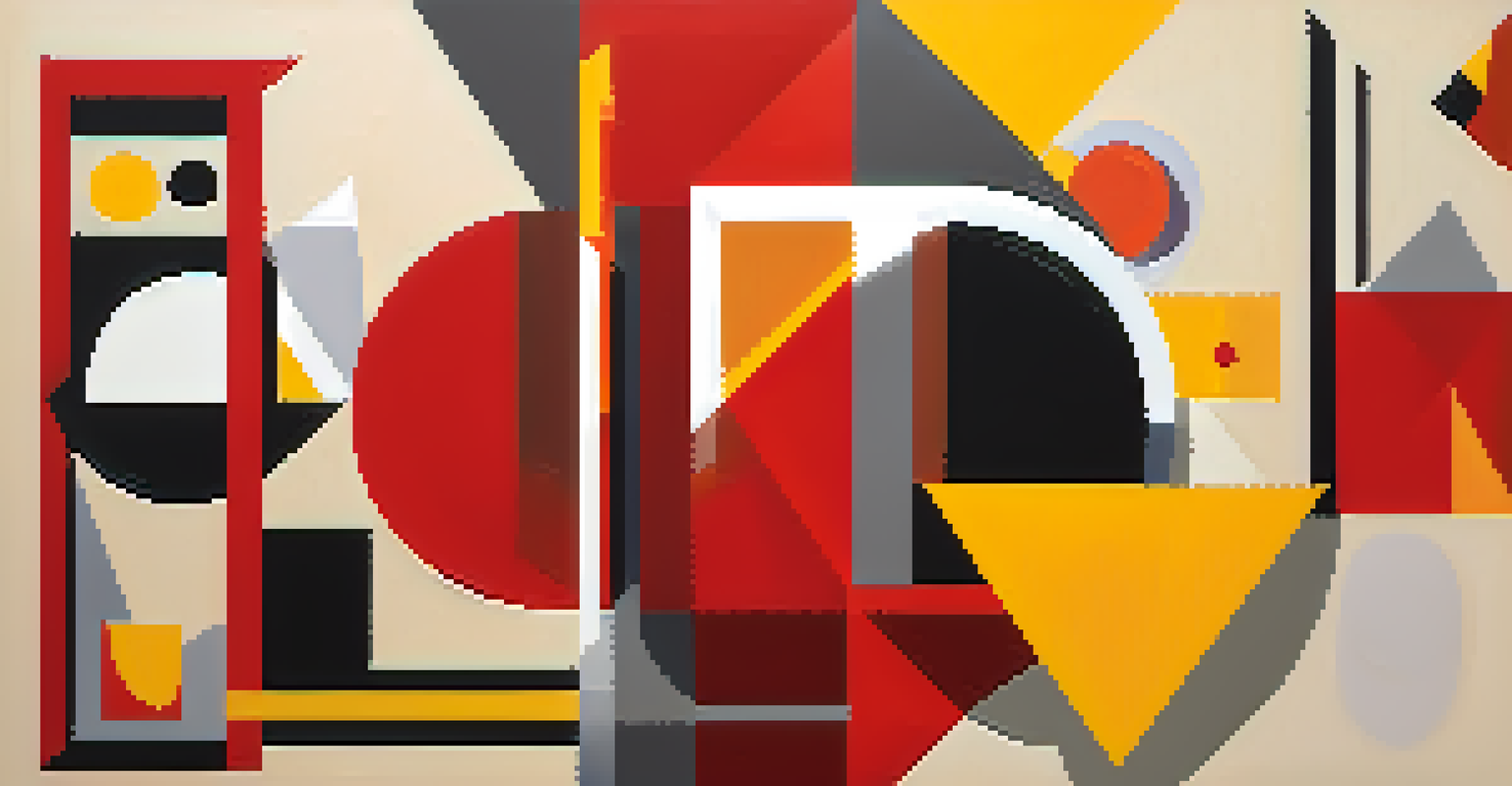Visual Storytelling: Techniques in Abstract Painting

Understanding Visual Storytelling in Abstract Art
Visual storytelling in abstract art refers to the ability to convey emotions and narratives without relying on realistic representation. This technique allows artists to express complex ideas through colors, shapes, and forms. For instance, a swirling mass of vibrant colors can evoke feelings of chaos or joy, depending on the viewer's perception. By breaking away from traditional forms, abstract artists invite us to interpret their work through our own experiences.
Abstract art is not a departure from reality but a way of seeing it more clearly.
The beauty of abstract painting lies in its openness to interpretation. Unlike figurative art, where the subject is clear, abstract pieces challenge us to look deeper and find our own meanings. A single brushstroke can represent movement, while a sharp contrast in colors might signify conflict. This subjectivity not only engages the viewer but also allows for a more personal connection to the artwork.
Ultimately, visual storytelling in abstract art encourages dialogue between the artist and the audience. It transforms the act of viewing into an interactive experience, where emotions and thoughts can flow freely. As we engage with these pieces, we're invited to explore our own stories, making the experience uniquely ours.
The Role of Color in Abstract Visual Narratives
Color is a powerful tool in abstract painting, playing a crucial role in visual storytelling. Different colors evoke various emotions; for example, blues can convey calmness or sadness, while reds often symbolize passion or intensity. Artists use this emotional language to guide the viewer’s feelings and responses to the artwork. A well-placed splash of yellow can be the light in a dark piece, drawing the eye and sparking joy.

Moreover, the combination of colors can create a sense of harmony or tension. An artist might choose complementary colors to create a vibrant contrast that captures attention, or they might use analogous colors to produce a soothing effect. The choice of color schemes is not random; it’s a deliberate decision that enhances the narrative within the painting. It’s like an orchestra, where each color plays its part to create a symphony of emotions.
Emotions Drive Abstract Art
Abstract art conveys emotions and narratives through colors, shapes, and forms, inviting personal interpretation.
As viewers, recognizing the significance of color in abstract art can deepen our appreciation. We begin to see beyond the surface and understand the emotional undertones that shape our experience. This awareness can transform how we engage with art, allowing us to connect on a more profound level with the narratives being told.
Shapes and Forms: Building Blocks of Abstract Stories
Shapes and forms are fundamental elements in abstract painting, acting as the building blocks of visual narratives. Each shape can represent different concepts; for instance, circles often symbolize unity or wholeness, while jagged lines can suggest conflict or tension. By manipulating these forms, artists create a visual language that communicates complex ideas without the need for words. It’s like a game of charades, where shapes act out their meanings.
Art is the most beautiful of all lies; it is an illusion that leads to the truth.
Furthermore, the arrangement of shapes within a composition can lead the viewer’s eye and influence the overall narrative. A cluster of sharp, angular forms may create a sense of urgency, while gentle curves can evoke tranquility. The spatial relationship between these shapes also adds depth to the storytelling, inviting viewers to explore the connections and contrasts within the piece. This dynamic interaction can make viewing abstract art an exciting journey.
In essence, shapes and forms in abstract painting serve as a means of expression, allowing artists to convey their inner thoughts and feelings. As we learn to read these visual cues, we become more adept at interpreting the stories behind the art. This understanding transforms our experience, enriching our connection to the artwork and the artist's intent.
Texture: Adding Depth to Visual Narratives
Texture is another vital aspect of abstract painting that enhances visual storytelling. It refers to the surface quality of the artwork, which can be smooth, rough, layered, or flat. Artists often use various techniques to create texture, such as layering paint, incorporating mixed media, or utilizing texture tools. This tactile quality invites viewers to not only see the art but feel it, creating a more immersive experience.
Different textures can evoke distinct emotional responses. For instance, a rough, chaotic surface might suggest struggle or turmoil, while a smooth, polished finish can communicate calmness and serenity. This interplay between visual and tactile elements enriches the narrative, making it more dynamic. Just as a well-written story has layers, textured paintings unravel their narratives through physical depth.
Color Shapes Emotional Responses
The use of color in abstract painting plays a crucial role in guiding viewer emotions and enhancing the narrative.
As we explore texture in abstract art, we learn to appreciate the complexity of visual storytelling. It encourages us to engage more fully, using our senses to interpret the artist's intentions. This multi-dimensional approach to art transforms our viewing experience into an exploration of feelings and ideas, enhancing our connection to the piece.
Movement: Capturing Energy in Abstract Art
Movement in abstract painting can be seen as the visual representation of energy and emotion. Artists often use lines, shapes, and color combinations to suggest motion, creating a sense of rhythm within the artwork. For instance, swirling patterns may evoke the feeling of wind, while sharp, diagonal lines can suggest action or urgency. This dynamic quality invites viewers into a narrative filled with life and vitality.
By incorporating movement, artists can convey narratives that resonate with our own experiences. A painting that embodies chaos might reflect internal conflict, while one that flows gently can symbolize peace and harmony. This ability to capture movement allows abstract art to transcend static representation, engaging the viewer in a more dynamic way. It's like watching a dance unfold, where every brushstroke contributes to the overall performance.
In recognizing movement within abstract paintings, we deepen our understanding of the stories being told. It encourages us to explore not just what we see, but also what we feel as we engage with the artwork. This exploration of energy and emotion can transform our experience, making it a personal journey through the artist's vision.
Symbolism: Layers of Meaning in Abstract Art
Symbolism plays a significant role in abstract painting, adding layers of meaning to visual storytelling. Artists often incorporate symbols—whether intentional or abstracted—to convey messages that resonate with viewers. For example, a triangle might represent stability, while a spiral could signify growth or evolution. This use of symbols invites interpretation and encourages viewers to delve deeper into the narrative.
The beauty of symbolism in abstract art is its capacity to evoke different meanings for different people. Each viewer brings their own experiences and perspectives, allowing the same piece to tell multiple stories. This multi-faceted approach enriches the viewing experience, as we each discover our unique interpretations. It's like a conversation, where every participant adds their voice to the discussion.
Symbolism Deepens Interpretation
Symbolism in abstract art adds layers of meaning, allowing viewers to connect with the artwork on a personal level.
As we engage with abstract paintings, recognizing the symbols can enhance our appreciation of the artist's intent. It transforms our viewing experience into a personal exploration, where we connect emotionally with the work. This journey through symbolism opens up new avenues for understanding, making abstract art a powerful medium for storytelling.
Emotional Resonance: The Heart of Visual Storytelling
Emotional resonance is perhaps the most crucial element of visual storytelling in abstract painting. It refers to the ability of a piece to evoke strong feelings and connect with the viewer on a deeper level. Artists often pour their emotions into their work, creating pieces that reflect their inner worlds. This authenticity can resonate with viewers, sparking emotions that may mirror their own experiences.
When we look at an abstract painting, we're often drawn to the emotions it stirs within us. Whether it’s joy, sadness, anger, or serenity, these feelings can create a powerful connection to the artwork. This shared emotional landscape transforms viewing into an intimate experience, making us feel understood and connected. It's like finding a kindred spirit in the colors and forms on the canvas.

Ultimately, the emotional resonance of abstract art is what makes it impactful. It encourages us to reflect on our own lives, experiences, and feelings. By tapping into this emotional core, artists invite us to join them on their journey, creating a shared narrative that transcends words, making art a universal language.